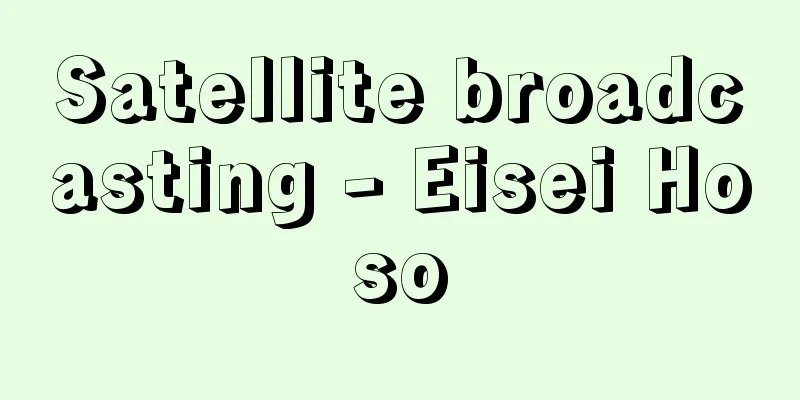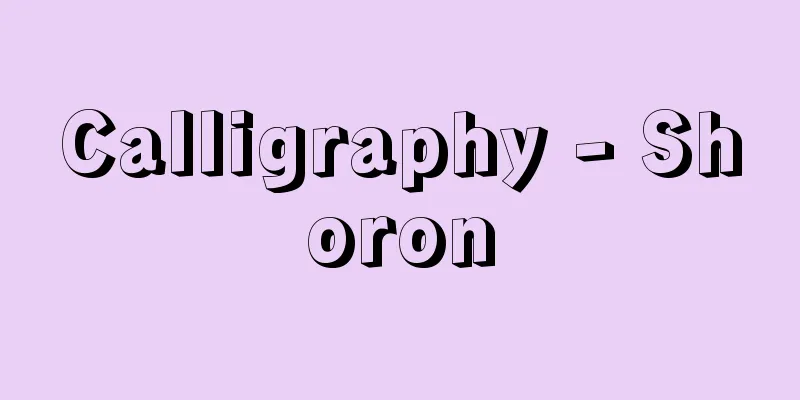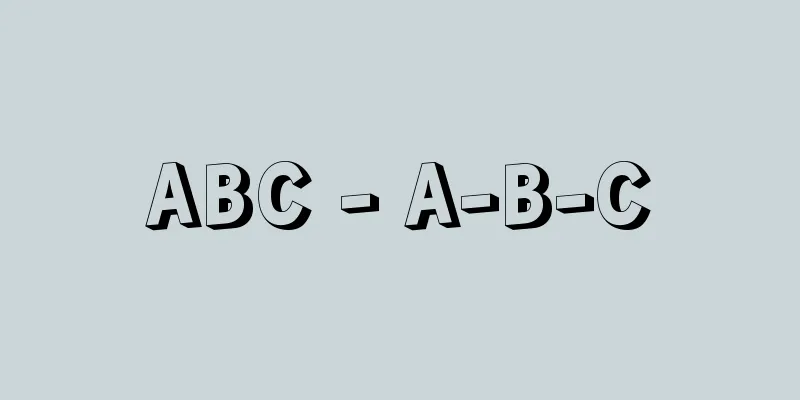Satellite broadcasting - Eisei Hoso

|
Broadcasting via outer space using artificial satellites as space stations. In a broad sense, it also includes satellite relay using communications satellites (abbreviated as CS), but in a narrow sense, it refers to broadcasting by broadcasting satellites (abbreviated as BS) intended for direct reception by the general public. In this case, the scope of satellite broadcasting is not limited to one country, but also includes broadcasts aimed at a wide area that targets the public of multiple countries. [Goto Kazuhiko] Mobile and geostationary satellitesThe first communications satellite to be used for television broadcasting, which receives, relays, and transmits signals on its own, was Telstar 1, launched in July 1962. Television signals sent from a ground station in Andover, Maine, were relayed by Telstar and received in the US, the UK, and France. On November 23, 1963, Relay 1 successfully relayed television signals between Japan and the US. During this first relay broadcast experiment, a trans-Pacific television broadcast reported the assassination of US President Kennedy, causing a big stir. These satellites are low- and medium-altitude satellites, and because their periodicity does not match the rotational period of the Earth, their communication time at one location is limited to a dozen minutes, so they are called mobile satellites. In contrast, satellites called geostationary satellites are located about 35,800 km above the equator and revolve around the Earth at nearly the same speed as the Earth's rotation (a period of about 24 hours), so they appear to be stationary from Earth's perspective and can therefore, in theory, be used 24 hours a day. The use of geostationary satellites became practical with the experimental launch of Syncom 2 in July 1963, and Syncom 3's relay of live coverage of the Tokyo Olympics to the United States, Canada and Europe in August of the following year, 1964. International broadcasting using communications satellites gradually became more commonplace and is now commonplace. [Goto Kazuhiko] How satellite broadcasting worksSatellite broadcasting in the narrow sense is also called direct satellite broadcasting, and refers to the direct reception of radio waves from satellites by antennas in ordinary homes. In Japan, the first direct broadcasting satellite DBS (Direct Broadcasting Satellite) experiment was conducted by "Yuri" in April 1978. Based on the results of this experiment, a practical broadcasting satellite (called BS-2, the next broadcasting satellite after "Yuri") was launched by a domestic rocket in January 1984, and a test television broadcast was conducted. NHK began test broadcasting of two channels with BS-2b, launched in February 1986, and began regular broadcasting of Satellite TV 1 and Satellite TV 2 in June 1989 (Heisei 1). Furthermore, Japan Satellite Broadcasting (JSB, nicknamed WOWOW, pronounced wow-wah), the first private satellite broadcasting, began broadcasting with BS-3, launched in August 1990. Thus began the era of full-scale satellite broadcasting. shows how satellite broadcasting works, using BS-2 as an example. BS-2 is a broadcasting satellite with two TV channels, and NHK's broadcasting programs can be received adequately even in remote islands and outlying areas by using the satellite, and high-quality broadcasting waves can be enjoyed without any interference even in high-rise cities. As shown in , satellite broadcasting can be received in two ways: individual reception, where each household with a simple receiving device receives the program directly, and community reception, where the program is received via a distribution communication system in a limited area such as an apartment building in a city or on a remote island. In addition, broadcasting satellites can be used for broadcasting from mobile earth stations for program transmission that can be moved by car in emergencies, as shown the diagram. The position and attitude of broadcasting satellites launched into geostationary orbit are controlled by the Communications and Broadcasting Satellite Corporation (a corporation established in August 1979 based on the Communications and Broadcasting Satellite Corporation Act). The configuration of receiving equipment in an individual home that directly receives satellite broadcasting waves is shown in . Broadcasting satellites can be used for a variety of broadcasting, not just normal television broadcasting. Broadcasting satellites are increasingly being used as space highways for a variety of new broadcasting. For this reason, homes that receive individual broadcasting will be equipped with a variety of equipment. shows a full range of equipment compatible with the various new services being envisioned in Japan and other countries. [Goto Kazuhiko] First phase of practical satellite broadcastingIn Japan, two types of satellite broadcasting are established: BS broadcasting by broadcasting satellites and CS broadcasting by communication satellites. BS broadcasting is divided into analog and digital broadcasting. As of 2007, NHK and the private WOWOW are broadcasting analog, while NHK and seven general broadcasting companies (commercial broadcasters) are broadcasting digitally. Many of the programs on BS digital broadcasting are high definition. Also, PCM audio broadcasting by broadcasting satellites is carried out by satellite digital music broadcasting. As of March 1998, the estimated number of households receiving BS satellite broadcasting was over 13 million, about 30% of all households. Meanwhile, CS broadcasting by communication satellites offered two multi-channel services, Sky Perfect TV and DirecTV, but DirecTV was merged into Sky Perfect TV in 2000. Both of these television broadcasts are digital. CS analog broadcasting, which began in 1992, was abolished in 1998. In addition to these satellite broadcasts, there is also NHK's international satellite television broadcast and the Open University of Japan's CS television broadcast. In 2004, a "mobile broadcasting" satellite broadcasting service for mobile devices was launched, which made it possible to receive video, audio and data on in-car and mobile phones, televisions, radios and personal digital assistants (PDAs), making it possible to watch outside or in a moving car. Until now, private terrestrial broadcasting stations have entered the market after NHK established the foundations for widespread adoption, and have not had to collect viewing fees directly from viewers. However, when private businesses undertake satellite broadcasting, they must enter into paid reception contracts with viewers with whom they have no previous experience. Meanwhile, in urban areas, so-called urban CATV companies are offering a huge number of channels and inviting viewers to subscribe. As the number of media and channels increases, competition to attract viewers is becoming increasingly fierce. Private satellite broadcasting services will likely face a difficult time from a management perspective for the time being as they compete with terrestrial television broadcasting, cable television, and the new entrant digital television. [Goto Kazuhiko] Towards the era of digital broadcastingThe first BS-4 satellite was launched in 1997, but this was the last analog BS satellite. The second BS-4 satellite, launched in 2000, was digitalized, and BS broadcasting was also digitalized from December 2000, just like CS broadcasting. It is expected that digital will be the norm for both BS and CS from 2011 onwards, and sooner or later terrestrial stations and cable television will also be in the digital era. The Open University's television broadcasting has been CS digital since January 1998. If these broadcasts, which have been in separate formats until now, are digitized, the distinction between broadcasting satellites and communication satellites will no longer be meaningful. It is expected that various signals other than broadcasting will be transmitted through the numerous channels of these transmission routes, so it would be better to think of the boundary between broadcasting and communication as disappearing. Not only satellite broadcasting but the entire broadcasting industry will be completely different from what it has been until now. [Goto Kazuhiko] "Basic knowledge of broadcasting satellites" by Endo Keiji and Izumi Takehiro (1973, Kenrokukan Publishing)" ▽ "The Age of New Media: Everything about Broadcasting Satellites" edited by the Broadcast Critics Association (1981, Kioi Shobo) ▽ "Guide to Receiving Satellite Broadcasts" edited by the Television Society (1996, Corona Publishing) [Reference] | | | | | |©Shogakukan "> How satellite broadcasting works (Diagram) The broadcasting satellite (BS-3a) was launched on August 28, 1990. It continued to provide satellite broadcasting together with the backup satellite "Yuri 3b" that was launched afterwards, and ceased operation in April 1998. ©JAXA "> Broadcasting satellite "Yuri 3a" (conceptual drawing) Source: Shogakukan Encyclopedia Nipponica About Encyclopedia Nipponica Information | Legend |
|
宇宙空間を経由し、人工衛星を宇宙局として行われる放送。広義には通信衛星communications satellite(略称CS)を利用して行われる衛星中継をも含めるが、狭義には一般公衆によって直接受信されることを意図した放送衛星broadcasting satellite(略称BS)による放送をいう。この場合、衛星放送の対象範囲は一国内に限られるわけではなく、複数の国の公衆を対象とする広い地域向けのものも含む。 [後藤和彦] 移動衛星と静止衛星衛星自体で受信、中継、送信をする通信衛星で最初にテレビ中継に用いられたものは、1962年7月に打ち上げられたテルスター1号である。アメリカのアンドーバー(メーン州)の地上局から送られたテレビ電波はテルスターで媒介され、アメリカおよびイギリス、フランスで受信された。1963年(昭和38)11月23日にはリレー1号により日本―アメリカ間のテレビ中継が成功した。たまたまこの初の中継放送の実験中、太平洋横断テレビ中継がアメリカ大統領ケネディ暗殺事件を報じたため、大きな話題となった。これらの衛星は低・中高度の衛星で、衛星の周期が地球の自転の周期にあわないため、一地点での通信利用の時間が十数分に限られるので移動衛星とよばれる。これに対して静止衛星とよばれる衛星は、赤道上約3万5800キロメートル上空にあり、地球の自転とほぼ同じ速さ(周期約24時間)で地球の周囲を回るので、地球からは静止しているようにみえ、したがって理論上は24時間の利用が可能である。この静止衛星の利用は、1963年7月の試験的なシンコム2号の打ち上げ、さらに翌1964年8月のシンコム3号による東京オリンピック実況のアメリカ、カナダ、ヨーロッパへの中継以来実用化し、通信衛星利用の国際的な放送の中継はしだいに活発となり、今日ではすっかり日常的なものとなった。 [後藤和彦] 衛星放送の仕組み狭義の衛星放送はまた直接衛星放送ともいわれ、衛星からの電波を一般家庭のアンテナで直接受信する形をとる。日本の場合、最初の直接放送衛星DBS(Direct Broadcasting Satellite)の実験は1978年4月の「ゆり」によって行われた。この実験の結果をもとに実用放送衛星(BS-2とよばれる。「ゆり」に次ぐ放送衛星の意)が国産ロケットによって、まず1984年1月に打ち上げられ、テレビ試験放送が行われた。1986年2月に打ち上げられたBS-2bからNHKは2チャンネルの試験放送を開始、1989年(平成1)6月より衛星第1テレビ、衛星第2テレビの本放送を開始した。さらに1990年8月に打ち上げられたBS-3では、初の民間衛星放送である日本衛星放送(JSB。愛称WOWOW、ワウワウと読む)が放送を開始した。こうして本格的な衛星放送の時代が始まった。 BS-2を例として衛星放送の仕組みをに示す。BS-2はテレビ放送2チャンネルをもつ放送衛星で、NHKの放送番組が衛星の利用によって離島、辺地でも十分に受信でき、また、高層化する都市においても障害なく良質の放送電波を享受することができる。に示すように衛星放送では、簡易な受信設備を備えた各家庭が直接受信する個別受信と、都市のマンション、あるいは離島におけるように限定された区域で分配通信系を経由して受信する共同受信という2通りの受信の形がとられる。また、放送衛星は非常災害時には、これもに示すように車で移動できる番組送出用車載型地球局からの放送にも活用される。なお、静止軌道に打ち上げられた放送衛星の位置、姿勢などの制御は、通信・放送衛星機構(「通信・放送衛星機構法」に基づき1979年8月に設立された法人)の手で行われる。 衛星放送の電波を直接受信する個々の家庭の受信用機器の構成はに示すとおりである。放送衛星はかならずしも通常のテレビ放送のためばかりでなく、多様な放送に利用することができる。各種の新しい放送のための宇宙のハイウェーとして放送衛星が活用されつつある。そのため個別受信をする家庭においては、多様な機器を備えることになる。には、日本ならびに諸外国で構想されているさまざまの新しいサービスに対応した機器がひととおりあげられている。 [後藤和彦] 衛星放送実用第1期日本では放送衛星によるBS放送と通信衛星によるCS放送の二つの系の衛星利用の放送が定着している。BS放送にはアナログ放送とデジタル放送があり、2007年(平成19)現在、アナログ放送で放送を行っているのはNHKと民間のWOWOW、デジタル放送でテレビ放送を行っているのはNHKと一般放送事業者(民放)7社となっている。なお、BSデジタル放送では多くの番組がハイビジョン放送である。また、放送衛星によるPCM音声放送が衛星デジタル音楽放送により行われている。1998年3月の時点では、BS衛星放送の推計受信世帯数は1300万を超え、全世帯の約3割となっている。一方、通信衛星によるCS放送はスカイパーフェクTVとディレクTVの2系統の多チャンネル・サービスが行われていたが、2000年にディレクTVはスカイパーフェクTVに統合された。これらのテレビ放送はいずれもデジタル放送である。1992年に開始されたCSアナログ放送は1998年に廃止された。なお、これらの衛星放送以外にNHKが行う国際放送の衛星テレビ放送と放送大学学園が行う放送大学のCSテレビ放送がある。また2004年には、携帯端末向けの衛星放送「モバイル放送」サービスが開始され、車載型や携帯型の電話、テレビ、ラジオ、情報処理端末(PDA)により、映像、音声のほかデータが受けられるようになり、戸外や高速移動中の車内での視聴が可能になった。 これまでの地上の民間放送局は、NHKによる先行的な普及の基盤づくりのあとに進出し、しかも視聴者からの直接の視聴料の徴収の必要がなかった。しかし、民間の事業として衛星放送を行う場合、企業はこれまでに経験のない視聴者との有料受信の契約をとらなければならない。他方、都市部ではいわゆる都市型CATVがおびただしいチャンネルを用意して視聴者の加入を誘っている。メディアが増えチャンネルが増加しているなかで、視聴者の獲得をめぐっての競争はますます激しくなっている。民間企業による衛星放送サービスは地上のテレビ放送、ケーブルテレビ、新参入のデジタルテレビとの競争の経過のなかで当分、経営的には困難な時期を迎えることになろう。 [後藤和彦] デジタル放送の時代へ1997年にはBS-4先発機が打ち上げられたが、これはアナログ方式のBSの最後のものである。2000年に打ち上げられたBS-4後発機はデジタル化され、2000年12月からBS放送もCS放送同様にデジタル化されている。2011年以降はBSもCSもデジタルが基本となる見込みで、遅かれ早かれ地上局、ケーブルテレビまで含めてデジタル時代になる。放送大学のテレビ放送は、1998年1月からCSデジタル放送となっている。これまで別々の形態であったこれらの放送がデジタル化すれば、もはや放送衛星、通信衛星の区分けも意味のないこととなる。これらの伝送経路のおびただしいチャンネルで放送以外のさまざまな信号も伝送されることになると予想されるので、放送と通信の境目もなくなってしまうとみたほうがいい。衛星放送だけではなく放送全体がこれまでとはまったく様相を異にしたものとなることであろう。 [後藤和彦] 『遠藤敬二・泉武博著『放送衛星の基礎知識』(1973・兼六館出版)』▽『放送批評懇談会編『ニューメディアの時代 放送衛星のすべて』(1981・紀尾井書房)』▽『テレビジョン学会編『衛星放送受信の手引』(1996・コロナ社)』 [参照項目] | | | | | |©Shogakukan"> 衛星放送の仕組み〔図〕 1990年(平成2)8月28日に打ち上げられた放送衛星(BS-3a)。その後に予備機として打ち上げられた「ゆり3号b」とともに衛星放送の提供を続け、1998年4月に運用を停止した©JAXA"> 放送衛星「ゆり3号a」(イメージ図) 出典 小学館 日本大百科全書(ニッポニカ)日本大百科全書(ニッポニカ)について 情報 | 凡例 |
>>: Satellite town - satellite town
Recommend
Xylene - English spelling: xylene
An aromatic hydrocarbon. It is also known as xylo...
Rock drill (sakuganki)
A machine that drills holes in rocks, mainly for b...
Turtle hole - Turtle hole
→Pothole Source: Shogakukan Encyclopedia Nipponic...
Stumpf - Carl Stumpf
German psychologist. Born near Würzburg, he loved...
Metal oxide electrode
…They introduced carboxyl groups to a graphite el...
Color Gold
…Because of its yellow color, it was also called ...
Planoudēs, Maximos
[Born] 1255. Nicomedia [died] c.1305 Byzantine phi...
Shozo Ogiya
1913-1992 A journalist and critic from the Showa ...
Off Beat Music
...This music originated in the early 20th centur...
Low calorie foods - low calorie diet
Foods that have reduced calorie sources such as su...
Charcot-Marie-Tooth disease - Charcot-Marie-Tooth disease
Chronic progressive muscular atrophy was reported ...
Caprilli, F.
...In the 19th century, Comte Antoine d'Aure ...
Kejawén (English spelling)
Java is an abstract noun formed by adding the pref...
Bone marrow transplant
◎Method and efficacy of bone marrow transplantatio...
Fish ladder
A fishway . A facility that allows fish to go upst...









